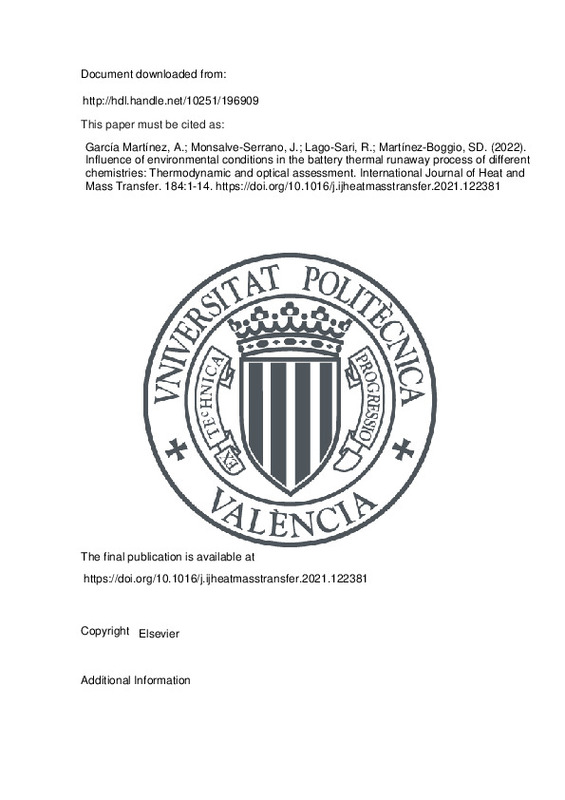JavaScript is disabled for your browser. Some features of this site may not work without it.
Buscar en RiuNet
Listar
Mi cuenta
Estadísticas
Ayuda RiuNet
Admin. UPV
Influence of environmental conditions in the battery thermal runaway process of different chemistries: Thermodynamic and optical assessment
Mostrar el registro sencillo del ítem
Ficheros en el ítem
| dc.contributor.author | García Martínez, Antonio
|
es_ES |
| dc.contributor.author | Monsalve-Serrano, Javier
|
es_ES |
| dc.contributor.author | Lago-Sari, Rafael
|
es_ES |
| dc.contributor.author | Martínez-Boggio, Santiago Daniel
|
es_ES |
| dc.date.accessioned | 2023-09-21T18:05:25Z | |
| dc.date.available | 2023-09-21T18:05:25Z | |
| dc.date.issued | 2022-03 | es_ES |
| dc.identifier.issn | 0017-9310 | es_ES |
| dc.identifier.uri | http://hdl.handle.net/10251/196909 | |
| dc.description.abstract | [EN] Thermal runaway is one of the main concerns of battery electric vehicles due to the hazard level that represents for the user and the surroundings. Several works studied different type of abuse in lithiumion cells and packs, but the understanding is still insufficient in terms of the combustion process. In this study, three different lithium-ion cell chemistries (LCO, NMC and LFP) are studied in two environmental conditions with different oxygen content (0 and 21%) in a continuous flow vessel to understand if the use of inert atmosphere may be a pathway to avoid thermal runaway. In addition, detailed optical research is conducted together with temperature sensing to understand the venting through the vent cap before the thermal runaway. The combustion is recorded with a high-speed camera (60 0 0 fps) while the venting is visualized through a Schlieren technique with another high-speed camera (12,0 0 0 fps). The thermodynamic results show that the venting process can be detected by a cell surface temperature decrease of around 5 degrees C, while the thermal runaway is seen as a battery self-heating (cell temperature higher than the ambient) and a suddenly increase of temperature until 700 degrees C in the surface of the cell. The optical access to the combustion chamber allows to observe with detail the venting of liquid electrolyte amongst the gases generated by the thermal abuse. In addition, the combustion records show that with inert atmosphere the combustion it is not initiated, and the process is restricted to smoke ejection. By contrast, the case of air (21% O 2 ) resulted in combustion outside the battery cell with high increase of the air temperature. In terms of battery chemistry, the Lithium, Ferrum, Phosphate (LFP) shows the highest safety time and lowest chamber temperatures. LCO and Nickel Manganese Cobalt (NMC) had similar behaviour in terms of safety time and temperature behaviour, but Lithium Cobalt Oxygen (LCO) shows more variation with respect to the atmosphere (reactive and inert) than NMC. (c) 2021 Elsevier Ltd. All rights reserved. | es_ES |
| dc.description.sponsorship | The authors want to acknowledge: Operación financiada por la Unión Europea a través del Programa Operativo del Fondo Europeo de Desarrollo Regional (FEDER) de la Comunitat Valenciana 2014-2020 con el objetivo de promover el desarrollo tecnológico, la innovación y una investigación de calidad. As well as the: Proyecto IDIFEDER/2021/053, Equipamiento para el estudio del fenómeno de combustión no controlada en baterías de vehículos eléctricos, entidad benificiaria Universitat Poliécnica de Valéncia. Lastly: Proyecto IDIFEDER/2020/34, EQUIPAMIENTO PARA EL DESARROLLO DE PLANTAS PROPULSIVAS HÍBRIDAS LIMPIAS Y EFICIENTES A TRAVÉS DEL USO DE E-FUELS, entidad beneficiaria Universitat Politècnica de València. | es_ES |
| dc.language | Inglés | es_ES |
| dc.publisher | Elsevier | es_ES |
| dc.relation.ispartof | International Journal of Heat and Mass Transfer | es_ES |
| dc.rights | Reconocimiento - No comercial - Sin obra derivada (by-nc-nd) | es_ES |
| dc.subject | Battery thermal runaway | es_ES |
| dc.subject | Electric vehicles | es_ES |
| dc.subject | Fire | es_ES |
| dc.subject | Lithium-Ion battery | es_ES |
| dc.subject | Safety | es_ES |
| dc.subject.classification | MAQUINAS Y MOTORES TERMICOS | es_ES |
| dc.title | Influence of environmental conditions in the battery thermal runaway process of different chemistries: Thermodynamic and optical assessment | es_ES |
| dc.type | Artículo | es_ES |
| dc.identifier.doi | 10.1016/j.ijheatmasstransfer.2021.122381 | es_ES |
| dc.relation.projectID | info:eu-repo/grantAgreement/GENERALITAT VALENCIANA//IDIFEDER%2F2021%2F053//EQUIPAMIENTO PARA EL ESTUDIO DEL FENOMENO DE COMBUSTION NO CONTROLADA EN BATERIAS DE VEHICULOS ELECTRICOS/ | es_ES |
| dc.relation.projectID | info:eu-repo/grantAgreement/GV INNOV.UNI.CIENCIA//IDIFEDER%2F2020%2F034//EQUIPAMIENTO PARA EL DESARROLLO DE PLANTAS PROPULSIVAS LIMPIAS Y EFICIENTES A TRAVES DEL USO DE E-FUELS / | es_ES |
| dc.rights.accessRights | Abierto | es_ES |
| dc.contributor.affiliation | Universitat Politècnica de València. Escuela Técnica Superior de Ingeniería del Diseño - Escola Tècnica Superior d'Enginyeria del Disseny | es_ES |
| dc.description.bibliographicCitation | García Martínez, A.; Monsalve-Serrano, J.; Lago-Sari, R.; Martínez-Boggio, SD. (2022). Influence of environmental conditions in the battery thermal runaway process of different chemistries: Thermodynamic and optical assessment. International Journal of Heat and Mass Transfer. 184:1-14. https://doi.org/10.1016/j.ijheatmasstransfer.2021.122381 | es_ES |
| dc.description.accrualMethod | S | es_ES |
| dc.relation.publisherversion | https://doi.org/10.1016/j.ijheatmasstransfer.2021.122381 | es_ES |
| dc.description.upvformatpinicio | 1 | es_ES |
| dc.description.upvformatpfin | 14 | es_ES |
| dc.type.version | info:eu-repo/semantics/publishedVersion | es_ES |
| dc.description.volume | 184 | es_ES |
| dc.relation.pasarela | S\451923 | es_ES |
| dc.contributor.funder | GENERALITAT VALENCIANA | es_ES |
| dc.contributor.funder | European Regional Development Fund | es_ES |







![[Cerrado]](/themes/UPV/images/candado.png)

